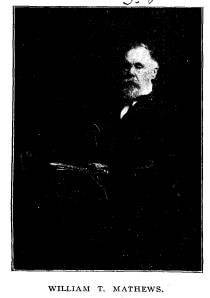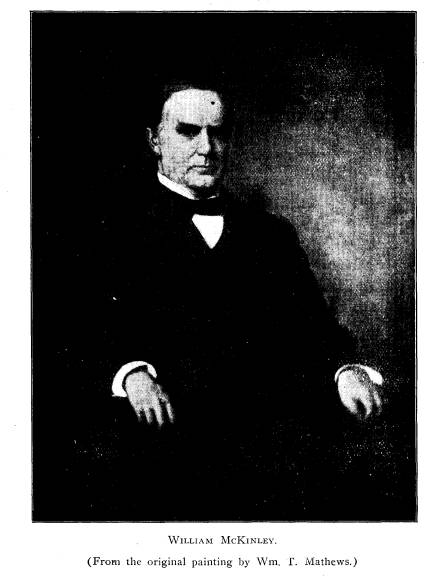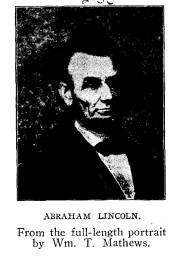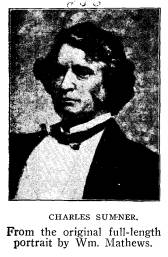Ohio History Journal
|
WILLIAM THOMAS MATHEWS.
[The following sketch of William T. Mathews, one of the most distinguished painters of our state and generation, was prepared by his brother, Major Charles H. Mathews, New Philadelphia, Ohio, and is a sympathetic tribute to the memory of the notable citizen, who was known as the "Buckeye Artist."- EDITOR.] William T. Mathews, bachelor artist, was a resident of Washington, D. C., for ten or fifteen years previous to his death, |
|
|
which occurred at the Emer- gency Hospital, January 11, 1905. He was then in his eighty-fourth year. The fun- eral services were held at the apartments of Mrs. Matilda Mathews, sister-in-law, Can- ton, Ohio, Saturday after- noon, January 14, 1905. Ma- jor C. Mathews and Mr. E. P. Mathews, brothers of the deceased, were the nearest relatives in attendance. Be- ing a Spiritualist, the services were conducted along the line of that association by Mrs. Cora Morrell, of Grand Rap- ids, Mich., who was ordained by The National Spiritualist's Association at Washington. |
|
D. C. His brother, Major C. H. Mathews, spoke briefly of the high character of the deceased. Both of the brothers were over eighty years of age, the Major being eighty-five. The remains were laid to rest in the West Lawn Cemetery, Canton: "Soul-soothing Art! which morning, noontide, even, Do serve with all their changeful pageantry; (396) |
|
William Thomas Mathews. 397 |
|
|
398 Ohio Arch. and Hist. Society Publications.
Thou, with ambition modest yet sublime,
Here, for the sight of mortal man, hast
given
To one brief moment caught from fleeting
time,
The appropriate calm of blest
eternity."
It is with much trepidation that the
writer essays to do
simple justice to a dear junior brother,
whose genial character
and lovely disposition charmed all who
came within the halo
of his sacred and sublime influence. He
was one of the most
unselfish men I ever knew:
"To trace each future of departed
worth,
Distinguished excellence in fitting
terms
Portray, and virtue eminent proclaim;
How vain the task! Alone, then let the
hand
Of gratitude inscribe this simple truth,
Beloved by all he lives, by all lamented
died."
In quiet garden spots of thought
throughout the world, live
those who act as centers of influence.
By the law of natural
affinity they draw toward them the good
in whatever form found,
giving forth more abundantly than they
receive. The fire of
aspiration ever glows in these places.
One such sanctuary lies
under the roof of a towering building,
far above the crowded
streets of a busy metropolitan. Here dwells a master of art
and life. Over the door is the inscription,
visible to grateful
patrons of the arts: "All ye who
enter here, leave care behind."
Within sits the master, old in years,
yet young, weaving the
spiritual truth and beauty of the ages
into brilliant, many-hued
pictures. From invisibility there come
forth, beneath the stroke
of his brush, visible creations of the
eternal verities; embodiment
of great thoughts, supreme ideals, high
endeavor and triumphant
achievement.
William
Thomas Mathews was born in Bristol, England,
May 7th, 1821. When he was about eight
years old he was placed
under the tuition of Professor Corff,
organist of the Bristol Ca-
thedral, under the auspices of "The
Established Church of Eng-
land," where he was thoroughly
catechized and attended school.
He had a fine soprano voice and was one
of the leaders among
the twelve choristers in that
time-honored cathedral, which dates
back nearly one thousand years. The
great cathedral bell still
William Thomas Mathews. 399
swings just as it swung over the heads
of the monks of St.
Augustine at their morning prayers six
hundred years ago. The
cathedral and a grand old Norman gateway
leading to quiet
precinct and echoing cloister, are all
that now remain of the
splendid Abbey of the Augustine Order,
demolished at the com-
mand of Henry VIII. when the monastic
houses were dissolved.
All around us are the sculptured marble
monuments; the floor
beneath our feet contains the tombstones
of dead generations.
The organ music rises soft and slow:
"Untwisting all the chains that tie
The hidden soul of Harmony."
It was in these sacred and solemn
precincts that our sub-
ject began his useful career. In the
year 1833 the Mathews fam-
ily sailed for the United States. From
the management of a
small farm in the vicinity of Canton,
Ohio, William turned to
learn the process of making tinware from
Henry Bockins, one
of the substantial business men of
Canton's early days. The
time thus spent between '33 and '34 was
regarded by the young
man of lofty ideals as time lost; in
acquiring a business which
he never afterwards pursued.
In 1844 he taught a select school in
Winnesburg, Holmes
county, Ohio. In the winter of 1845 he
went to Cincinnati; at
least we find him there in February,
1846, saying: "I am going
to paint a picture for a young lady
here, as I must have practice.
I have commenced a portrait of the lady
I board with. Mr. Soule
says I ought to paint altogether from
life. I practice a good
deal and learn something every day. I
expect to commence a
portrait for a Mr. Barnes, a former
printer in the Gazette office.
I have the use of a piano here and am
improving on the guitar."
A Columbus paper, January, 1894, says:
"Mr. Wm. T. Ma-
thews, who is painting Gov. McKinley's
picture, began his ca-
reer as an artist in Cincinnati in 1845.
He went there from
Canton, Ohio. He took with him several
pictures as evidence
of his handiwork. His purse being light,
he stopped 'Over the
Rhine.' His pictures he hung on the wall
to beautify his room.
The German proprietor was attracted by a
picture of 'Bos-
ton Harbor,' with sailing vessels. When
Mr. Mathews returned
400 Ohio Arch. and Hist. Society Publications.
the landlord asked the price and was
told twenty dollars. He
said: 'You stop by me and I buy him.'
The bargain was soon
made, and this was the first picture Mr.
Mathews ever sold. A
local artist, Insco Williams, persuaded
him that he was a natural
artist and that it would be wrong for
him to fritter away time
at other business and offered him a
position without pay in his
studio. Mr. Mathews is now recognized as
one of the leading
portrait painters in the United
States." In speaking in later
years of this period of his life, he
said: "My fortune was made.
I could see six weeks of undisturbed
possession of myself. I
walked, or rather strode, down the
street with the feeling of one
who owned about everything in sight. I
passed a drug store
to which I had been recommended for a
position with a sense
of relief and I called on my friend
Mathias Weaver. He intro-
duced me to William Miller, the
miniature painter, who intro-
duced me to Charles Soule, the leading
portrait painter of Cin-
cinnati. He asked me what I was going to
do in Cincinnati?
I showed him some of my work. He
promptly said: 'You were
intended for a painter. Don't make the
fatal blunder I did by
going at business not suited to your
talents.' These words made
a deep impression on my mind. He asked
me to call again, and
said: 'I live out of town. I would like
this studio opened by
9 o'clock a. m. If you would like to
come here and open up
and entertain callers, you can paint
here as much as you like.'
This effectually disposed of the drug
business. Some kind friends
had mentioned me favorably to the
'Gazette' people, and the next
thing I knew the great daily had blazed
forth the news that
another artist had arrived and would
join the group of artists
who were making the Queen City famous as
the Cradle of Amer-
ican Art."
That Professor Mathews thought and
studied deeply, is
evident from fugitive productions found
among his papers. That
he did not leave a succinct
autobiography is deeply to be re-
gretted.
"Art," says he, in a written
essayette, "is the manifestation of
the Ideal of a people. This signifies
that the artist is supposed to
take the most exalted and unbiased view
of human character
and to depict it with fairness, always
evincing a sacred regard
|
William Thomas Mathews. 401
for truth; not that kind of regard which induces the artist to search for every little flaw and blemish on the surface, but to present the most favorable side of the subject and impress the spectator with the breadth and grandeur of Nature. American civilization leaves on the mind a sense of rawness and restless- ness; the imagination turns for relief to the future. There is no escaping the conclusion that there awaits America a material and moral destiny unparalleled in history, despite the aesthetic |
|
|
|
barrenness of to-day. Of all the peo- ple of Italy who have made an im- pression on modern life, none inter- ests us more than the Etruscans; they have left a written language which no one can interpret. Stupen- dous works which time fails to de- stroy, and a high and suggestive art whose preservation is due to the silence of the grave during thirty centuries of slumber. If America, during her opportunity of material prosperity, does not secure a high position in Art and Literature, in her decadence she too will disappear from history as did Eutruria, leav- ing only a great shadow on the dial |
|
plate of time." Mr. Mathews made painting a practical study for twenty- five years. He was a member of the National Academy of De- sign in New York, and was thought by his brother artists to have achieved success. His productions and the verdict of the art critics attest the genuineness of his reputation. A long, inti- mate and friendly association with the leading painters of this country, involving of course, a mutual comparison and inter- change of ideas, enabled him to speak somewhat authoritatively upon art matters. He said: "The popular idea of painters and the profession, is sometimes wide of the truth, very naturally. There is no great mystery about it; no saintly nor seraphic halo. Painting is a science as well as an art, and has certain definite Vol. XV.-26. |
402 Ohio Arch. and Hist.
Society Publications.
rules and principles, the same as any
other science which re-
quires careful study. A natural bent
combined with great en-
thusiasm and industry are the requisites
for success. The es-
sential principle of painting relate to
outline or modeling-you
might call it drawing-and the variation
of light and shade.
You can have a good picture by combining
these skillfully,
without the use of color. On the other
hand, skillful coloring
may make a tolerable picture out of
indifferent outlines and
lights and shadows. An artist may be a
great painter and lack
in color. He can hardly be so and lack
in the other essentials.
Perfection in all is requisite in
attaining the highest rank."
Near the close of his career it was the
aim of Professor
Mathews to paint a thoroughly American
picture of a represen-
tative American. He chose William
McKinley as the highest type
of our nationality. When Artist Mathews
was in Washington,
nearly twenty years ago, President
McKinley was then chairman
of the Ways and Means Committee. He associated with him,
saw him in the halls of Congress, heard
his speeches, walked
with him upon the streets, and was with him in his home. As
a sitter the artist says he found Mr.
McKinley the same grave,
dignified, courteous, gentleman that he
always was. It was one
of the desires of the artist that the
portrait should show itself
a thoroughly apparent type of the
American school, and one
that would commend itself to his
countrymen. The portrait
sows the strong, uncompromising,
qualities of the man, with his
conscious force disclosed in every
feature. It presents the man
when fewer cares had been borne and
lesser battles fought. The
picture, the artist hoped, was one that
would be regarded as a
faithful portraiture of a man known the
world over. Any one
with a critic's eye, who has seen the
McKinley portrait by Mr.
Mathews can well understand Ex-Speaker
Henderson's remark
to the artist: "Mr. Mathews,"
said Mr. Henderson, when the
portrait was on exhibition at the
Corcoran Art Gallery in Wash-
ington, "the American people should
never forget the service
you have rendered them in preserving the
features of President
William McKinley in so truthful and
artistic a manner."
The portrait of President McKinley was
first publicly shown
in Pittsburgh a few years ago, where it
attracted general at-
|
William Thomas Mathews. 403
tention and received great commendation. The Pittsburgh daily from which we make our extract says: "Mr. Mathews has had a wide range of experience in art, and his portraiture has been largely of representative Americans. He painted two portraits of Bryant, the poet, that are highly regarded as faithful likenesses and admirable works of art. It was the friendship of this great poet and journalist, who was at that time editor of the Evening Post, and his kind and beautifully written criticisms, that helped along the artist, then struggling, |
|
|
as all artists do, to have his pictures hung in the National Academy in New York, where, afterward, for twenty-five years, he was an exhib- itor. He has painted among others, pictures of Lincoln, Daniel Webster, 'Prince John' Van Buren, full-length portraits of Lincoln and Sumner for the South Carolina legislature. Also Gov. William Allen of Ohio, Gov. Richard M. Bishop of Ohio, James A. Garfield, two of Mr. McKinley and one of Mrs. McKinley. Mr. Mathews was regarded by all possessing powers of critical ap- preciation to be one of the greatest portrait artists of his day. He was |
|
not only an adept in the technique of his profession, namely that of accurate and correct drawing, of the law of perspective, and a most delightful and successful colorist, but as a portrait painter he had that further and rarer gift of delineating the subjective character of his subject upon the canvas. This tribute to his proficiency is easily sustained by all of the portraits which he painted, and they were many. While the artist was more prom- inent before the public in the career of Mr. Mathews, his char- acter and qualities of mind were no less admirable. He was a most genial friend, a delightful conversationalist, enjoying ever the association of kindred spirits. He left behind him the mem- |
404 Ohio Arch. and Hist. Society Publications.
ory of a mind equipped with rare
accomplishments and of a char-
acter whose influence could not cease
with his demise.
"Yes, the grave hath quenched that
eye, and
Death's relentless frost,
Withered that arm: but the unfading fame
*
* * the remembrance
With which the happy spirit contemplates
Its well-spent pilgrimage on earth,
Shall never pass away."
ODE FOR STANTON
DAY.*
Written by Prof. George C. S. Southworth
and read at the celebration
at Kenyon College, 26th April, 1906, in
memory of her distinguished
son, Edwin McMasters Stanton.
I.
Statesman and Jurist, entered into rest
What time our grand Republic loosed her
helm
After the toils of war! Among the blest
None shines more radiant in the heavenly
realm
Than he, whose name our laureate honors
overwhelm.
STANTON, the patient, fiery, masterful
and bold,
Persistent, wielding freedom's sword of
flame,
Man cast in the Arthurian, knightly mold
Whose blazon vibrates from the trump of
fame
Down the resounding avenues of time the
same.
As some fair star ascends the arch of
night,
While round the pole the constellations
wheel,
His good report mounts brighter and more
bright,
Resplendent in the galaxy of commonweal:
Beside his tomb a reverent people kneel.
II.
His perfect courage in that hour awoke
When craven counsels paralyzed the arm
* See article on Edwin M. Stanton by
Andrew Carnegie, page 291
supra.



